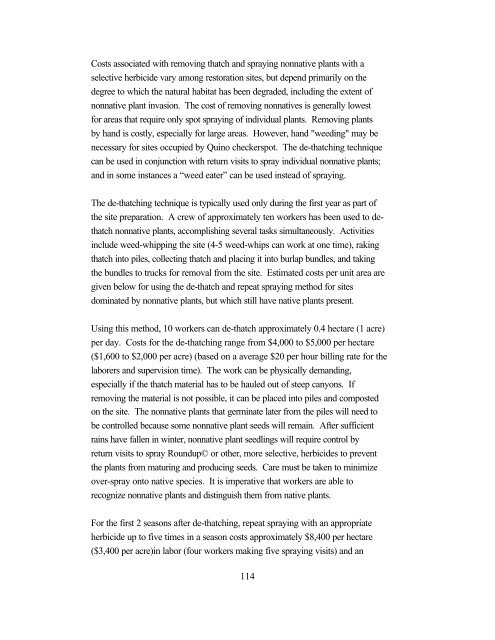Outline of Quino Recovery Plan - The Xerces Society
Outline of Quino Recovery Plan - The Xerces Society
Outline of Quino Recovery Plan - The Xerces Society
You also want an ePaper? Increase the reach of your titles
YUMPU automatically turns print PDFs into web optimized ePapers that Google loves.
Costs associated with removing thatch and spraying nonnative plants with a<br />
selective herbicide vary among restoration sites, but depend primarily on the<br />
degree to which the natural habitat has been degraded, including the extent <strong>of</strong><br />
nonnative plant invasion. <strong>The</strong> cost <strong>of</strong> removing nonnatives is generally lowest<br />
for areas that require only spot spraying <strong>of</strong> individual plants. Removing plants<br />
by hand is costly, especially for large areas. However, hand "weeding" may be<br />
necessary for sites occupied by <strong>Quino</strong> checkerspot. <strong>The</strong> de-thatching technique<br />
can be used in conjunction with return visits to spray individual nonnative plants;<br />
and in some instances a “weed eater” can be used instead <strong>of</strong> spraying.<br />
<strong>The</strong> de-thatching technique is typically used only during the first year as part <strong>of</strong><br />
the site preparation. A crew <strong>of</strong> approximately ten workers has been used to dethatch<br />
nonnative plants, accomplishing several tasks simultaneously. Activities<br />
include weed-whipping the site (4-5 weed-whips can work at one time), raking<br />
thatch into piles, collecting thatch and placing it into burlap bundles, and taking<br />
the bundles to trucks for removal from the site. Estimated costs per unit area are<br />
given below for using the de-thatch and repeat spraying method for sites<br />
dominated by nonnative plants, but which still have native plants present.<br />
Using this method, 10 workers can de-thatch approximately 0.4 hectare (1 acre)<br />
per day. Costs for the de-thatching range from $4,000 to $5,000 per hectare<br />
($1,600 to $2,000 per acre) (based on a average $20 per hour billing rate for the<br />
laborers and supervision time). <strong>The</strong> work can be physically demanding,<br />
especially if the thatch material has to be hauled out <strong>of</strong> steep canyons. If<br />
removing the material is not possible, it can be placed into piles and composted<br />
on the site. <strong>The</strong> nonnative plants that germinate later from the piles will need to<br />
be controlled because some nonnative plant seeds will remain. After sufficient<br />
rains have fallen in winter, nonnative plant seedlings will require control by<br />
return visits to spray Roundup© or other, more selective, herbicides to prevent<br />
the plants from maturing and producing seeds. Care must be taken to minimize<br />
over-spray onto native species. It is imperative that workers are able to<br />
recognize nonnative plants and distinguish them from native plants.<br />
For the first 2 seasons after de-thatching, repeat spraying with an appropriate<br />
herbicide up to five times in a season costs approximately $8,400 per hectare<br />
($3,400 per acre)in labor (four workers making five spraying visits) and an<br />
114
















